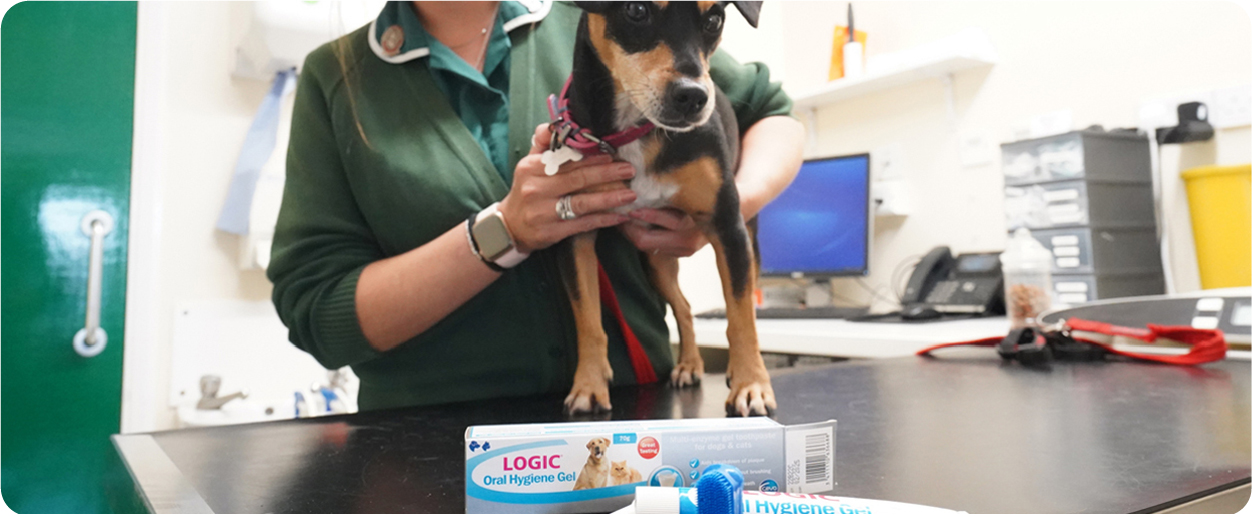Your pet’s preventative dental care should include both home care and regular dental check-ups with our vets. Should your animal develop dental problems, our Walnut Tree Hospital has a dedicated Dental Suite, which includes a fully comprehensive dental x-ray system.

Dental care at Milton Keynes Vets
Our dental services
The dental x-ray system at our Walnut Tree Hospital enables our vets to detect hidden dental disease within teeth and below the gum line.
Our Stoke Road surgery also has dental equipment and dental x-ray that enables veterinary surgeons to perform routine dentistry such as scaling and polishing teeth and extracting obviously diseased teeth. Our high-speed dental drills are suitable for treating routine dental disease in rabbits, such as trimming the front incisors to prevent overgrowth (a significantly safer method than using clippers which can easily damage or shatter teeth).
What causes dental disease?
Dental disease is extremely common in our pets, and it is estimated that 80% of pets over the age of three years have evidence of gum disease. Dental disease can be present in both young and older animals, but it does tend to be more common and more severe as our pets get older.
Dental disease is associated with the accumulation of dental plaque and tartar formation. You may also hear the term periodontal disease when it comes to your pet’s teeth, this is a disease that affects the teeth and the structures around them.
What is plaque?
Plaque develops on the surface of teeth and is a film of bacteria. A small amount of plaque will not be visible to the naked eye, but the layers will grow and become thicker over time.
What is tartar?
Tartar will develop over time if plaque is not removed from your pet’s teeth. As more plaque builds up, it becomes calcified and this is what we refer to as tartar.
What are the signs of dental disease?
Bad breath is the most common sign that your pet may have dental disease, but there are other symptoms:
- Bad Breath
- Pawing at mouth
- Difficulty eating
- Red or inflamed gums
- Brown discoloured teeth
- Facial swelling
- Excessive drooling
- Mobile teeth
Caring for your pet’s teeth at home
What can you do at home to help?
Cleaning of your pet’s teeth is the most effective way to prevent oral health problems. Teeth brushing lowers the risk of gum disease, dental disease and other dental-related illnesses.
To help keep your pet’s teeth and gums healthy, it is recommended for your pet’s teeth to be brushed 2-4 times a week as part of their routine.
Brushing your pet’s teeth: the fundamentals
Before brushing your pet’s teeth, it’s important to ensure you have the right equipment for the job. Make sure you have sourced a toothpaste that is specifically designed for animals. Depending on the size of your pet’s teeth and mouth, it may be suitable to use a regular toothbrush, however there are also specially designed pet toothbrushes and finger brushes that may be more suitable.
Starting your pet early with teeth brushing is key, as it allows them to become accustomed to the action and feeling. Make sure you provide your pet with reassurance to keep them calm and start initially once a week and build this up as they become more comfortable with the action.
Place a small amount of toothpaste on the toothbrush ready to start, and just allow your pet to taste it to begin. After this, pick up your toothbrush and gently brush their teeth in a massage-like motion.
Once they are comfortable with this, you can start brushing their teeth in a circular motion, paying attention to where the tooth meets the gum line. When you are nearly done, brush in a vertical motion to remove any plaque that may have been dislodged.
After finishing brushing their teeth, make sure to praise them for good behaviour.
Prescription diets are available that aim to slow down the build-up of tartar on your pet’s teeth. These typically work by mechanically rubbing against the tooth surface to help remove the plaque or contain ingredients which slow down the tartar build up.
Chews are available that are specifically designed to gently scrub the outside of your pet’s teeth as they bite down.
If you are unable to physically brush your pet’s teeth, another option that may provide some benefit are oral hygiene gels. These gels are squirted into the mouth, or placed on their paw so they have to lick it off. The licking action then spreads the gel around their mouths, where it sticks to the teeth and gums to help break down plaque as well as neutralise bacteria levels in their mouth.
PetsApp
You can use PetsApp by selecting the button on the bottom right of the page.
If you don’t have PetsApp on your smart phone, you can download it via the QR code below:
